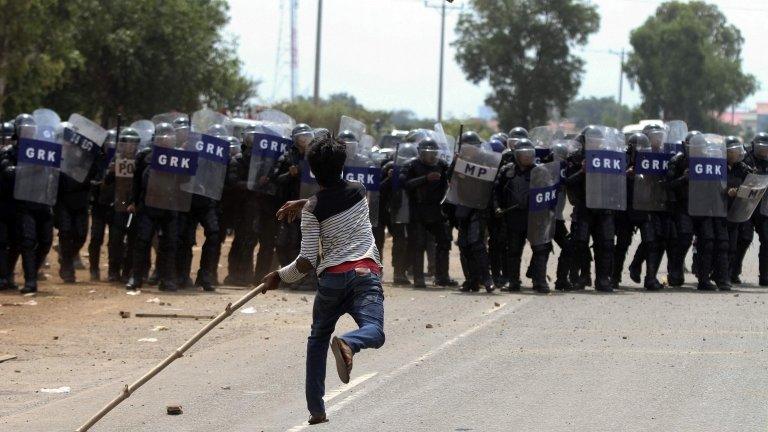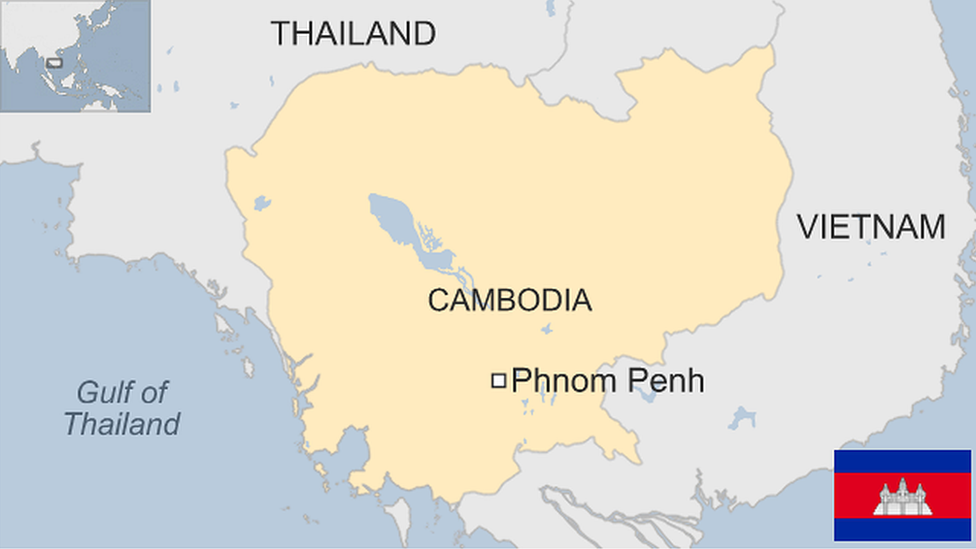Cambodia's garment industry at crossroads
- Published
Strikes at garment factories have quadrupled over the last year, as Karishma Vaswani reports
Nun Vanak is an excellent example of how Cambodia's garment manufacturing industry has helped to change lives of hundreds of thousands of people in this country.
The 23-year-old is part of Cambodia's half-a-million-strong workforce - mostly young women - that keeps these garment factories running.
Her income helps to provide for her and her young daughter, and like many others in the factories, she also sends money to her family back home in the village - a trend that has helped boost rural incomes.
But ask Nun, or her friends, whether they would want their daughters to end up as factory workers in the garment industry and the answer is a vehement no.
'Barely make enough'
These women, like so many of their counterparts, are getting increasingly angry.
"Our bosses make us work long hours, many times without a break and we barely make enough to survive," she tells me passionately, as we sit in her house surrounded by some of her friends.
The women have been taking part in protests.
Strikes and violent demonstrations at garment factories in Cambodia have quadrupled over the past year, and a recent report by the International Labour Organization (ILO) said that conditions at factories were worse now than they had been in recent years.
"We never have enough, especially for those workers who rent. Food is getting more expensive too," says Nun. "I have my own house, but I have to spend money on transportation and food.
"The employers don't know the difficulties we face. They think, 'Oh this money is enough for the workers', but it's not."
Cambodia has some of the lowest wages in the region.
Nun and her friends say they make $74 (£48) a month as garment factory workers - that's less than Cambodia's official minimum wage of $80 a month.
With overtime, the women can sometimes bring home $100 a month - still far less than what garment workers in other parts of Asia earn.
Wages v productivity
The sector, which accounts for 80% of Cambodia's total exports, is the lifeline of the country's economy.
However, the majority of factory owners in Cambodia are foreign. They have seen their businesses grow, thanks to a combination of low wages and a government keen on encouraging private enterprise.

Nun Vanak (left) and her friends have been protesting against low wages
But workers are now demanding higher wages, saying that strong growth in the economy means they should see some of those benefits trickle down to them.
For their part, industry bosses complain of intimidation and harassment, and say they can't afford to pay any more to their staff.
"These are not striking workers - these are hooligans," Ken Loo, the head of Cambodia's Garment Manufacturers Association, tells me as he plays video clips of violent protests outside a factory that supplies clothes to Nike.
The demonstration took place in June and made international headlines. Footage shows workers wielding wooden sticks and throwing rocks. Riot police were brought in to control the crowd.
Mr Loo says workers are getting increasingly militant and aggressive about their demands.
"As employers we do not object to strikes per se," he says, but they do object to "any strikes that result in violence".
He says the harsh reality is that garment factories just cannot afford to pay their workers more because they're under so much pressure themselves.
"You say our wages are low, but the productivity in Cambodia is low too," he says. "Vietnam's wages might be double that of Cambodia, but their productivity is about double. So cost per unit output is the same.
Jill Tucker, ILO: "The end of cheap garments is near"
"If you compare against countries like Bangladesh - their wages are half, but their productivity is probably slightly lower but not a huge percent lower. So our unit cost per production is higher. "
Stalemate?
International observers say it is unlikely the stand-off between workers and factory owners is going to end soon.
"I do believe that wages haven't kept up with inflation and that is very challenging for garment workers," says Jill Tucker, the chief technical adviser with the ILO's Better Factories programme in Cambodia.
"As such, I think the demonstrations in Cambodia are going to continue for some time."
According to Ms Tucker, the solution lies with the consumer.
"If you look at the global garment industry, you'll see that wages have risen across the board, material costs have risen, energy costs have risen, but none of us are paying more for our garments than we were a decade ago," she says.
"We have closets full of garments and we're paying the same amount or less. So it's very hard for factories to make a buck. Hopefully this is going to change,
"I think the era of cheap garments has maybe a few years left and maybe that's about it."
Cambodia is a nation on the move, but its garment industry is at a crossroads.
How this issue is settled, may well decide what direction it takes from here.
- Published25 July 2013

- Published3 June 2013

- Published22 August 2023
